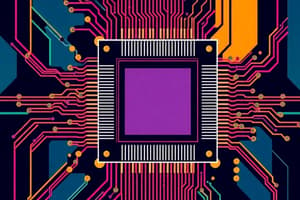Podcast
Questions and Answers
What is the first step in the fetch stage of the instruction cycle?
What is the first step in the fetch stage of the instruction cycle?
The CPU sends the address in the PC to the MAR.
During the decode stage, what does the control unit read to determine what action is required?
During the decode stage, what does the control unit read to determine what action is required?
The IR
What happens during the execute stage of the instruction cycle?
What happens during the execute stage of the instruction cycle?
The control unit signals the appropriate components to perform the operation, and the ALU processes data for arithmetic or logical instructions.
What is the purpose of pipeline processing in modern CPUs?
What is the purpose of pipeline processing in modern CPUs?
What happens when an interrupt is detected during the instruction cycle?
What happens when an interrupt is detected during the instruction cycle?
What is the primary purpose of the Fetch Stage in the instruction cycle?
What is the primary purpose of the Fetch Stage in the instruction cycle?
What is the role of the control unit in the Decode Stage?
What is the role of the control unit in the Decode Stage?
What occurs during the Execute Stage of the instruction cycle?
What occurs during the Execute Stage of the instruction cycle?
What is the purpose of the Store/Write-back Stage in the instruction cycle?
What is the purpose of the Store/Write-back Stage in the instruction cycle?
What is the role of the Program Counter (PC) in the instruction cycle?
What is the role of the Program Counter (PC) in the instruction cycle?
Flashcards are hidden until you start studying
Study Notes
Instruction Cycle
- The instruction cycle, also known as the fetch-decode-execute cycle, is the fundamental operational process of a computer's central processing unit (CPU).
- The CPU continuously repeats the instruction cycle from the time the computer is powered on until it is shut down.
Fetch Stage
- Retrieves an instruction from the memory.
- The Program Counter (PC) holds the address of the next instruction to be executed.
- The address is sent to the memory address register (MAR), and the instruction is fetched from memory and loaded into the memory buffer register (MBR) or instruction register (IR).
- The Program Counter is then incremented to point to the next instruction in sequence.
Decode Stage
- Interprets the fetched instruction.
- The fetched instruction in the IR is decoded by the control unit.
- The instruction is divided into components, including the opcode (operation code) and the operand(s).
- The control unit determines the type of operation to be performed and what resources are needed (e.g., registers, ALU, etc.).
Execute Stage
- Carries out the decoded instruction.
- Based on the decoded instruction, the necessary data transfers occur.
- The arithmetic logic unit (ALU) performs calculations if the instruction involves arithmetic or logical operations.
- For memory operations, the data might be read from or written to memory.
- The result of the operation is stored in the appropriate register or memory location.
Store/Write-back Stage
- Stores the result of the execution back into memory or a register (if necessary).
- If the instruction requires storing the result, the data is written back to the specified location in memory or to a register.
- The CPU then prepares for the next instruction cycle by moving to the fetch stage again.
Instruction Cycle Variations
- Pipeline Processing: Modern CPUs often use pipeline processing, where different stages of multiple instructions overlap, improving efficiency.
- Interrupt Handling: If an interrupt is detected, the current cycle is paused, the CPU saves its state, processes the interrupt, and then resumes the instruction cycle.
Studying That Suits You
Use AI to generate personalized quizzes and flashcards to suit your learning preferences.




